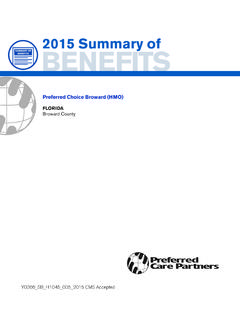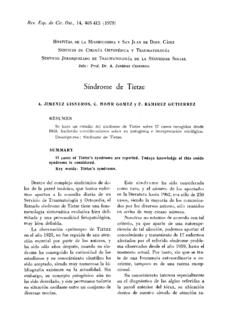Transcription of Management of Acute Pain and Chronic …
1 Section IV: Management of AcutePain and ChronicNoncancer PainPain Monograph 5/5/06 2:42 PM Page 59A . AC U T EPA I NThis section reviews the general approach tothe treatment of Acute pain , including treatmentgoals, therapeutic strategies, and elements ofpain Management . It also provides an overview( , summary tables) of the treatment of somecommon types of Acute Treatment GoalsAs addressed in Section , Acute pain is acomplex multidimensional experience that usu-ally occurs in response to tissue trauma. Whereasresponses to Acute pain may be adaptive, theycan have adverse physiologic and psychologicalconsequences ( , reduced tidal volume, exces-sive stress response, progression to Chronic pain ,inability to comply with rehabilitation, patientsuffering and dissatisfaction). Acute pain is moredifficult to manage if permitted to becomesevere,1so prompt and adequate treatment ofacute pain is imperative.
2 Treatment goals andstrategies for Acute pain can be summarized as:!Early intervention, with prompt adjustmentsin the regimen for inadequately controlledpain !Reduction of pain to acceptable levels!Facilitation of recovery from underlying dis-ease or Therapeutic analgesiaRecent research on postoperative pain man-agement supports a treatment approach knownas multimodal analgesia or balanced analge-sia. This approach involves the use of morethan one method or modality of controlling pain ( , drugs from two or more classes, drug plusnondrug treatment) to obtain additive beneficialeffects, reduce side effects, or may operate through different mecha-nisms or at different sites ( , peripheral versuscentral actions). One example of multimodalanalgesia is the use of various combinations ofopioids and local anesthetics to manage postop-erative 32 summarizes some specif-ic examples of multimodal of multimodal analgesia include earli-er oral intake, ambulation, and hospital dis-charge for postoperative patients as well as high-er levels of participation in activities necessaryfor recovery ( , physical therapy).
3 6-7It alsomay reduce postoperative morbidity, mortality,and pain experts advocate revisionof traditional postoperative care programs toinclude accelerated multimodal postoperativerecovery potential appli-cations of multimodal analgesia include othertypes of Acute , as well as Chronic , analgesiaPreemptive analgesia refers to the administra-tion of one or more analgesic(s) prior to a nox-ious event ( , surgery) in an attempt to pre-vent peripheral and central sensitization, mini-mizing post-injury pain (see ,8). Compellingevidence of the efficacy of preemptive analgesiaexists in animal models, and human studies haveproduced some promising results. For example,the preoperative administration of selectivecyclooxygenase-2 (COX-2) inhibitors decreaseduse of morphine after spinal fusion surgery inone recent is also some evidencethat preoperative epidural blockade (local anes-thetic and opioid with or without clonidine)may reduce the incidence of phantom limb painin patients undergoing limb , other studies have failed to confirmthat preemptive analgesia prevents phantomNational Pharmaceutical Council61 Section IV: Management of Acute pain and Chronic noncancer PainTable 32.
4 Examples of Multimodal TherapyCombination of AgentsExampleSystemic NSAID aplus PO Ibuprofen plus POsystemic opioidhydromorphone Systemic NSAID plus IV ketorolac plus epiduralepidural opioid and local fentanyl and bupivacaine anestheticSystemic NSAID plus local IV ketorolac plus lidocaine infiltration of anesthetic plus infiltration of surgical site systemic opioidplus IV PCA morphineRegional block plus systemic Intraoperative anesthetic NSAID plus epidural opioid plus IV ketorolac plus and local anestheticpostoperative fentanyl andbupivacaine epiduralSource: Reference need to be used with care in surgical patients due tothe risk of bleeding ( anti-platelet effect).IV: intravenous; NSAID: nonsteroidal anti-inflammatory drugs;PCA: patient-controlled analgesia; PO: per os (oral). pain Monograph 5/5/06 2:42 PM Page 61limb ,13-14 Furthermore, a recent review of40 controlled clinical studies revealed no differ-ence in the intensity and duration of postopera-tive pain after preemptive analgesia with a vari-ety of failure to demonstrate clini-cal efficacy may reflect failure to identify theoptimum method or timing for instituting theanalgesia.
5 Some investigators contend that mul-tiple factors ( , extent and nature of the dam-aged tissue, duration of the surgery, choice ofdrug, route and timing of administration, timecourse of central sensitization) may influencethe ability to demonstrate a preemptive anal-gesic , clinical research into itspotential clinical benefits is Elements of managementPharmacologic Management is the corner-stone of Acute pain Management . Multiple fac-tors ( , pain intensity, quality, and pattern;patient preferences; drug side effect profiles)influence the selection of medications. Mostacute pain is nociceptive and responds to nono-pioids and opioids. However, some adjuvantanalgesics ( , local anesthetics) also are usedto manage Acute pain . In general, mild somatic pain responds well tooral nonopioids ( , acetaminophen, nonster-oidal anti-inflammatory drugs [NSAIDs]), topi-cal agents ( , local anesthetics), and physicaltreatments ( , rest, ice, compression, eleva-tion).
6 1 Moderate to moderately severe acutepain is more likely to require often are combined with opioids toimprove pain relief and diminish the risk of sideeffects. Various factors ( , preferred route ofadministration, time of onset, dosing frequency,side effect profile) influence the choice of indi-vidual agents in a drug class. Excessive concern about addiction and regula-tory scrutiny heavily contribute to the under-treatment of pain (see ,5). Analgesics, espe-cially opioids, are underprescribed and under-dosed for both Acute and Chronic pain . Moderateto severe Acute pain should be treated with suffi-cient doses of opioids to safely relieve the drug side effects preclude achieving adequatepain relief, the side effects should be treatedand/or another opioid should be tried. The con-comitant use of other analgesics ( , nonopi-oids, local anesthetics) and nonpharmacologicmethods ( , applied heat or cold, electroanal-gesia, relaxation) maximizes pain relief and min-imizes the risk of treatment-limiting side effects.
7 ApproachesNonpharmacologic approaches to Acute painmanagement should supplement, but notreplace, , the medical con-dition of some patients with Acute pain ( ,severe trauma or burns) may limit the use ofnonpharmacologic therapy. Postoperativepatients who receive preoperative instruction insimple psychological methods (Table 30) such asrelaxation and imagery are especially likely tobenefit. Thus, instruction in nonpharmacologicmethods of pain Management is an importantpart of the preoperative assessment (Table 12).Physical methods of pain Management can behelpful in all phases of care, including immedi-ately after tissue trauma ( , rest, application ofcold, compression, elevation) and late duringthe healing period ( , exercises to regainstrength and range of motion) (Table 31). 4. Management of Some CommonTypes of Acute PainTable 33 defines and presents examples ofsome common types of Acute pain , includingpain associated with an Acute illness, periopera-tive pain , posttraumatic pain (major and minor),procedural pain , and obstetrical pain .
8 Tables 34to 36 summarize some pharmacologic and non-pharmacologic approaches to the managementof these types of pain . The former category isdivided into medications administered via sys-temic routes (Table 34) and those administeredregionally ( , regional anesthesia)(Table 35).The reasons these pain types were selected fordiscussion include: !Their relatively high prevalence!The availability of effective pharmacologicand nonpharmacologic methods of manage-ment!The availability of clinical practice guidelines62 pain : Current Understanding of Assessment, Management , and TreatmentsSection IV: Management of Acute pain and Chronic noncancer PainaNikolajsen and colleagues13found that the rate and intensityof phantom and stump pain , as well as the consumption of opioids,did not differ significantly between 29 patients randomly assignedto receive epidural bupivacaine and morphine before, during, andfor 1 week after the lower-limb amputation and 31 control-grouppatients who received epidural saline before and during the ampu-tation then oral or intramuscular morphine.
9 Lambert et that a perioperative epidural block started 24 hours prior toamputation was not superior to the intra- and post-operative infu-sion of a local anesthetic via a perineural catheter in preventingphantom pain . However, the former did provide better relief ofstump pain during the immediate postoperative Monograph 5/5/06 2:42 PM Page 62(CPGs) outlining appropriate care !Evidence of undertreatment and/or nonadher-ence to relevant tables merely provide an overview oftreatments. They do not consider all of the risksassociated with treatments or the needs of spe-cial populations. The reader should refer to theappropriate CPGs to make specific managementdecisions. B . CH R O N I CNO N C A N C E RPA I NThis section reviews general approaches to thetreatment of Chronic noncancer pain (CNCP),including treatment goals, therapeutic approach-es, and elements of treatment. It also providesgeneral information about the treatment of somecommon types of CNCP ( , summary tables)and identifies relevant clinical practice guide-lines (CPGs).
10 1. Treatment GoalsAs discussed in Section , CNCP is adebilitating condition that often is associatedwith significant physical, emotional, and socialdisability. A complex interaction among thesefactors contributes to the persistence of , treatment should address importantsocial and psychological consequences of thepain as well as any physical pathology. Usuallythis entails a comprehensive approach thatincludes medication and functional rehabilitation helps the patientdevelop skills to manage the pain . It includespatient education, regular assessment, manage-ment of contributing illnesses ( , depression),and the setting of attainable treatment latter should take into account factors suchas the patient s acceptance of his or her condi-tion, the patient s motivation to participate intreatment, the patient s ability to follow throughwith recommendations, and the available timeand treatment goals forCNCP include:2,28-30!






